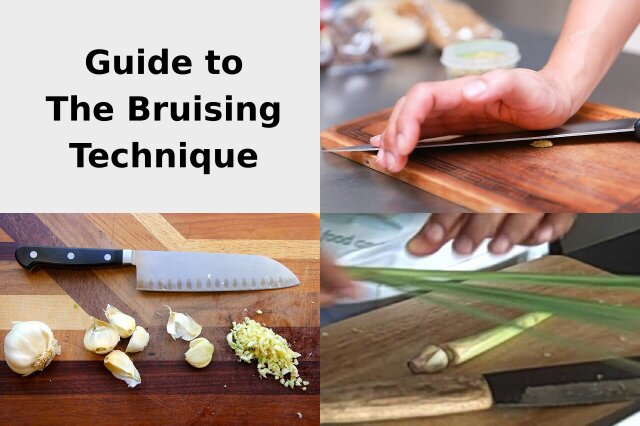If you’re new to cooking, you may have come across the term “bruise” in recipes and wondered what it means.
Bruising is a technique used to release the flavours and aromas of certain ingredients, such as herbs and spices.
In this guide, we’ll explain what bruising is and how to use it in your cooking.
What Does Bruise Mean in Cooking?
A Beginner’s Guide
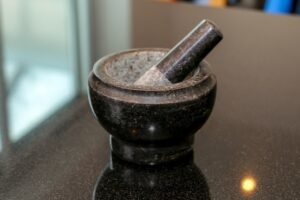
Welcome to my guide on bruising techniques in cooking!
As a beginner, you may not have heard much about this topic before, but trust me – learning how to properly bruise your ingredients can take your dishes to the next level.
In this article, I will cover everything you need to know about what does bruise mean in cooking, including different methods for achieving that perfect bruise, tips and tricks for getting started, and examples of recipes where bruising can make all the difference.
Whether you are looking to impress dinner guests, create more flavourful meals at home, or just expand your culinary skills, this guide has got you covered. So read on, learn something new, and start experimenting today!
What does it mean to “bruise” ingredients in cooking?
Bruising is a technique used to release the flavours and aromas of certain ingredients, such as herbs and spices.
It involves gently crushing or pressing the ingredient with a tool such as a mortar and pestle, the back of a knife, or even your hands.
This releases the oils and juices within the ingredient, intensifying its flavour and aroma.
Bruising is often used in recipes for cocktails, marinades, and dressings, as well as in dishes such as Thai papaya salad and Italian bruschetta.
Why is bruising used in cooking?
Bruising is used in cooking to enhance the flavour and aroma of certain ingredients. By releasing the oils and juices within the ingredient, the flavour becomes more intense and pronounced.
This technique is particularly useful for herbs and spices, which can have a subtle flavour that may be lost if not properly prepared. Bruising is also used to soften tough ingredients, such as meat, making them more tender and easier to cook.
The Power of Bruising Herbs and Spices in Your Cooking
Don’t just spice up your cooking, take it to the next level with our guide on Bruising Herbs and Spices!
Impress family and friends with your expertly seasoned dishes.
Commonly the result is achieved by crushing the item gently using a heavy knife, pestle or rolling pin.
Remember, this releases the full flavours of spices, citrus peel, lemongrass, etc.
Here’s why you should bruise herbs and spices in your recipes;
- Release aroma and flavour:
- Bruising release the essential oils of herbs and spices which contain their unique flavour and aroma.
If you need to add more depth of flavour to a dish, bruising your herbs can infuse the ingredients with that extra burst of taste. - Enhance colour:
- Bruised herbs and spices will also help add another element of visual appeal to a dish.
Fresh herbs such as parsley or oregano are vibrant when they are crushed, creating delightful flecks of green throughout the dish.Crushed red pepper flakes add fiery specs of colour to the plate, and paprika is an amazing garnish for giving traditional Spanish dishes a gentle orange shade that is pleasing to the eye as well as your taste buds.
- Better texture:
- Bruising your herbs also helps keep them from becoming too stringy or chewy while cooking – particularly tough herbs like mint or sage leaves.
By breaking down the fibrous stocks in each herb sprig before combining them with other food items such as marinades or hot pots.
Even smaller spices like coriander seeds can be difficult to chew through if left whole, but crushing those into fine powders ensures smoother culinary outcomes with minimal loss of flavour.
- Important for certain dishes:
- Some cuisines absolutely require bruised spices in order for its authentic flavours to stand out fully.
Take Italian cuisine, for instance! For some Italian recipes such as fish soups, there needs to be an aromatic paste composed of bruised garlic, onion, cherry tomatoes and chili peppers that maintains its consistency even after being cooked for hours at a time.
This gives those aromatic secrets a chance at being savored without any distractions from solid pieces getting in
between people’s teeth unexpectedly!
Recipes that benefit from bruising.
Bruising ingredients can add depth and complexity to many recipes. For example, bruising herbs like basil or mint can release their oils and enhance the flavour of a dish.
Bruising garlic can also intensify its flavour and aroma.
In addition, bruising meat can make it more tender and easier to cook. Recipes like pesto, marinades, and stir-fries often benefit from bruised ingredients.
Experiment with different techniques and ingredients to see how bruising can elevate your cooking.
- Guacamole;
- Bruising the avocado in guacamole can actually enhance the flavour and texture.
Simply mash the avocado with a fork or spoon until it is slightly chunky, and then mix in your desired ingredients like lime juice, diced tomatoes, and cilantro.
- Pesto;
- When making a pesto sauce, bruising the basil leaves can help release their oils and intensify the flavour.
Use a mortar and pestle or a food processor to gently bruise the leaves before adding in the other ingredients like garlic, pine nuts, and Parmesan cheese.
- Mojitos;
- Mojitos are a classic cocktail that benefit from bruising the mint leaves.
Use a muddler or the back of a spoon to gently bruise the leaves before adding in the rum, lime juice, and simple syrup.
- Salsa;
- Similar to guacamole, bruising the tomatoes and other ingredients in salsa can help release their flavours.
Use a fork or potato masher to gently crush the tomatoes before mixing in the other ingredients like onions, jalapeños, and cilantro.
- Caprese Salad;
- Bruising the basil leaves in a caprese salad can help release their oils and enhance the flavour.
Simply tear the leaves into small pieces and gently crush them with your fingers before layering them with sliced tomatoes and fresh mozzarella.
- Thai Papaya Salad;
- Thai papaya salad, also known as som tam, benefits from bruising the green papaya to help soften it and absorb the flavours of the dressing.
Use a meat tenderizer or the back of a knife to gently bruise the papaya before mixing it with fish sauce, lime juice, and chili peppers.
- Mint Tea;
- Bruising the mint leaves in tea can help release their oils and intensify the flavour.
Use a muddler or the back of a spoon to gently bruise the leaves before steeping them in hot water for a refreshing and flavourful tea.
Tools For Bruising Ingredients.
From mortar and pestle to rolling pins, there are various tools used for bruising food in cooking.
Learn about the different options and how to use them effectively.
- Mortar and Pestle;
- A mortar and pestle is a traditional tool used for bruising ingredients. It is made of two parts, a bowl-shaped mortar and a club-shaped pestle.
The ingredients are placed in the mortar, and the pestle is used to crush and grind them into a paste or powder.When choosing a mortar and pestle for bruising cooking ingredients, look for one made of a durable material such as granite or marble.
The size and weight of the mortar and pestle should also be considered, as a larger and heavier set will be more efficient for bruising larger ingredients.
Additionally, make sure the surface of the mortar is rough enough to effectively bruise the ingredients.
- Rolling Pin;
- A rolling pin can be used to bruise ingredients such as herbs and spices.
Simply place the ingredients on a flat surface, cover them with a cloth, and roll the pin over them until they are bruised to the desired consistency.
Some factors to consider when choosing a rolling pin for bruising cooking ingredients may include the material (such as wood or marble), the weight, the length, and the texture of the surface.
It is important to choose a rolling pin that is comfortable to use and fits your specific needs for bruising ingredients.
- Food Processor;
- A food processor is a modern tool that can be used to bruise ingredients quickly and efficiently.
Simply add the ingredients to the processor and pulse until they are bruised to the desired consistency.
When choosing a food processor for bruising ingredients, look for one with a powerful motor and sharp blades.
A large capacity bowl is also important, as it allows you to process larger quantities of food at once.
Additionally, consider the ease of cleaning and any additional features, such as different speed settings or attachments for slicing and shredding.
- Blender;
- A blender can also be used to bruise ingredients. Simply add the ingredients to the blender and pulse until they are bruised to the desired consistency.
When looking for a blender to crush or bruise ingredients, you want to make sure it has a powerful motor and sturdy blades.
Look for blenders with at least 1000 watts of power and blades made of durable materials like stainless steel.
You may also want to consider a blender with a tamper tool to help push down ingredients and ensure they are evenly blended.
- Meat Tenderizer;
- A meat tenderizer can be used to bruise ingredients such as garlic and ginger. Simply place the ingredient on a cutting board, cover it with a cloth, and use the flat side of the tenderizer to bruise it.
When choosing a meat tenderizer for bruising foods, look for one with sharp blades or spikes that can penetrate the meat easily.
You may also want to consider a meat mallet, which can be used to pound the meat and break down its fibers.
Additionally, consider the material of the tenderizer – metal or stainless steel tend to be more durable than plastic.
- Grater;
- A grater can be used to bruise ingredients such as nutmeg and cinnamon. Simply grate the ingredient until it is bruised to the desired consistency.
When choosing a grater for bruising ingredients like garlic or ginger, look for one with small, sharp teeth or blades.
A microplane grater is a great option, as it can easily grate these ingredients into a fine paste.
Make sure the grater is easy to clean and has a comfortable grip for easy use.
- Coffee Grinder;
- A coffee grinder can be used to bruise ingredients such as spices and herbs.
Simply add the ingredients to the grinder and pulse until they are bruised to the desired consistency.When choosing a coffee grinder for grinding spices, look for one with a strong motor and sharp blades.
It should also have the ability to grind to different levels of coarseness, as some recipes may require a finer grind than others.
Additionally, consider the size and capacity of the grinder, as well as its ease of use and cleaning.
- Muddler;
- A muddler can be used to bruise ingredients for cooking.
Simply place the ingredients in a bowl or mortar and use the muddler to gently press and twist them until they release their flavours and oils.
This technique is commonly used for herbs, fruits, and spices in cocktails and cooking.When choosing a muddler for bruising ingredients in cocktails or cooking, look for one that is made of sturdy material such as stainless steel or hardwood.
It should also have a comfortable grip and a flat or textured bottom to effectively crush ingredients without damaging them.
Consider the size and weight of the muddler as well, as this can affect how easy it is to use.
How to properly bruise ingredients.
To properly bruise ingredients, you will need a tool such as a mortar and pestle, a rolling pin, or even your hands.
For herbs and spices, gently crush them with the tool or between your fingers to release the oils and aromas.
For tougher ingredients like meat, use a meat mallet or the back of a knife to pound the meat, breaking down the fibres and making it more tender.
It’s important to be gentle when bruising ingredients, as over-bruising can result in a mushy texture and loss of flavour.
How to Bruise Garlic Cloves Like a Professional Chef.
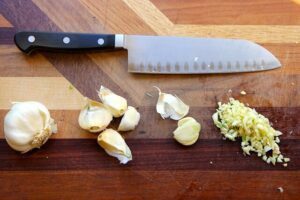 A bruised clove of garlic is often included in roast or stewed dishes and is usually removed after cooking, so you can often leave the skin on.
A bruised clove of garlic is often included in roast or stewed dishes and is usually removed after cooking, so you can often leave the skin on.
When you want a garlic flavour to penetrate a shallow layer of cooking oil when pan-frying, it’s necessary to bruise the whole clove so its flavour can be released.
Garlic crushers are wasteful, so let’s show you how to bruise garlic by hand.
All you need is your clove of garlic, a knife and a bit of rock salt, which also adds great flavour!
- Place a garlic clove on a chopping board. Holding a cook’s knife horizontally, position the blade over the clove.
- With the heel of your free hand and fingers raised away from the sharp edge, give the knife a firm whack to split the garlic.
- Leave skin on to roast or peel skin when pan frying.
A clove done in a garlic crusher is more likely to burn when cooking in hot oil.
How to Bruise Lemongrass for Maximum Flavour.
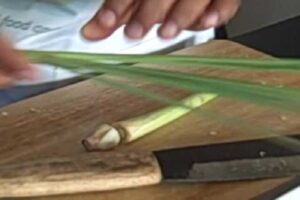 Lemongrass is a versatile herb used in all kinds of Asian recipes.
Lemongrass is a versatile herb used in all kinds of Asian recipes.
By bruising lemongrass you will get the most flavour out of this citrusy stalk so it is ready for cooking.
Learn how to bruise lemongrass so it is ready for marinades, curries, cocktails, stir-fries, and countless other preparations.
To get the most flavour out of this citrusy stalk and ready for cooking;
- Remove and discard the spiky top and the base plus the first few outer layers.
- Bruise the lemongrass stalk by lightly crushing it with a large knife pestle, a meat mallet, rolling pin or cleaver.
- You want to use the the spine or back of the blade to lightly hammer the lemongrass.
This will release even more flavours into your dish. - Be careful not to go too hard here, as bruising too harshly may break open some skins on your pieces of lemongrass and cause them to expel too much liquid.
How to Easily Bruise Cardamom Pods In No Time.
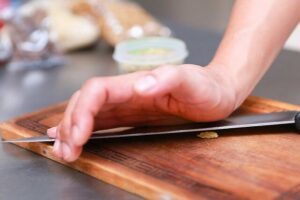 Cardamom is an intensely aromatic spice widely used in Indian cooking.
Cardamom is an intensely aromatic spice widely used in Indian cooking.
When you bruise cardamom you are releasing it ‘s oils which helps it combine with other flavours.
Bruising enhances the flavour and aroma of the spice by allowing the flavours of the inner seed to work its magic.
When you bruise cardamom pods, or any spice, you only need to barely break the outer seed coat, or husk.
- Place a few pods on a flat surface, such as a cutting board.
- Gently push down with the flat side of a large knife, partially cracking open the pod.
